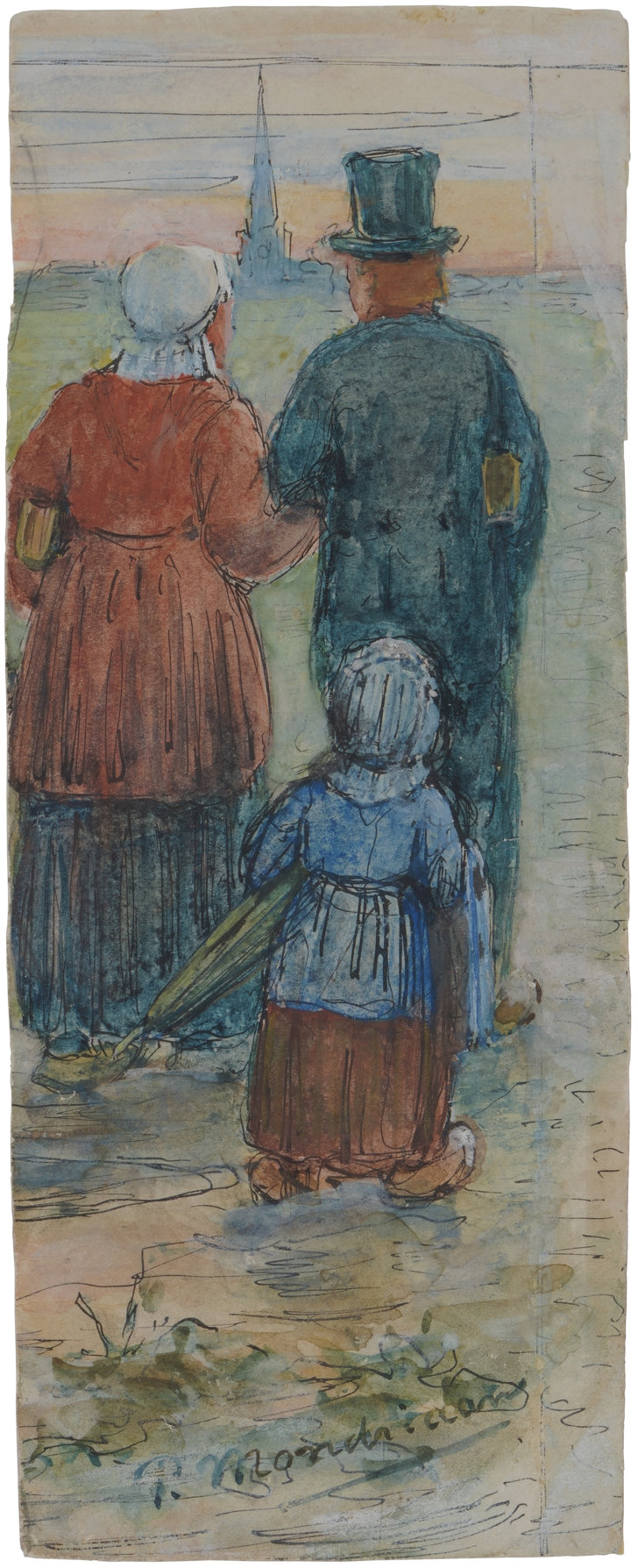Small Watercolor "Going to Church" recognized as a Real Mondriaan

A small watercolor that was examined for authenticity for a year and a half has been recognized by Mondriaan experts as an authentic, early work by Piet Mondriaan. It concerns a church-going family in traditional costume, painted between 1898 and 1901. The work will be included in the catalog raissoné at the National Office for Art Historical Documentation RKD in The Hague.
Frank Buunk of Simonis & Buunk Kunsthandel was the first to investigate the watercolor. It is an unusual work by Piet Mondriaan, but certainly by him. "The colors that Mondriaan has used here show strong similarities with a watercolor of a farm in Arnhem from 1901, which we sold in 1999. The technology is exceptionally good and the signature convincing.” Originally, the image appears to have been larger on the left, partly considering the fitting lines in the air on the right. “It is beautifully signed by Mondriaan, from which we can deduce that he saw this as a full-fledged work of art.”
Mondriaan must have been inspired by the work of Jan Braet von Überfelt, who often painted people in traditional costumes. Around 1889, Mondriaan received lessons from Braet von Überfelt in Doetinchem to obtain his 'Akte M.O. Signatures and Perspective'. Given the technology and color scheme, the church can be dated ten years later.
Curator Annegreet Kalteren of the Mondriaanhuis in Amersfoort is enthusiastic to hang and study Kerkgang next to two works from their collection in due course, because it shows strong similarities with The skating scene in Marken and the Summer conversation: Zuid-Beveland in Zeeland, both of which she dates around 1898-1901. It is these two works in the Mondriaanhuis that Buunk was able to definitively establish the authenticity of Kerkgang.
Piet Mondriaan was familiar with the Christian faith. He grew up in a Dutch Reformed family and was baptized a month after his birth in Amersfoort's Sint-Joriskerk, within walking distance of their house on the Kortegacht, where the Mondriaanhuis is now located. Religion remains important to Mondriaan, even if the Christian faith gradually makes way for a more spiritual attitude to life. In 1909 he joined the Theosophical Society.
Simonis & Buunk has a rich history with early work by Piet Mondriaan. The first early Mondriaan (Straatje in Winterswijk) came on the market in 1986 and the Ede art dealer had it auctioned at Christie's, where it was sold for 100,000 guilders to an American collector. The subsequent purchases consisted of two (color) drawings, initially doubted by Prof. Dr. Robert Welsh, but seven years later Joop M. Joosten showed in his catalog raisonné that they were very special (not to be dated to 1901). but from a much better year 1917, already with the angularity of Mondrian's period for which he became famous) because they could be traced directly back to the patronage of the circle of painters around Mondriaan.
After 2000, several discoveries followed, including the Farm behind a fence that was sold to a collector in London and now hangs in the Kunstmuseum The Hague and the beautiful find of Grazing Calves, a painting by Piet Mondriaan from 1902-1903 with the signature of F. Mondriaan turned out to be a P. The canvas was purchased in 2006 for 2,500 euros and recently auctioned by the customer of Simonis & Buunk for 180,000 euros in The Hague. The most famous early Mondriaan that Simonis & Buunk had in the collection is De Oostzijdse Molen aan het Gein bij moonlight, sold to the Rijksmuseum in 2005, where it occupies a prominent place in the permanent display.
Kerkgang will first be seen from April 20 in Villa Mondriaan in Winterswijk. An intriguing question to the audience: where is Kerkgang painted, given the church tower and Sunday clothes?
